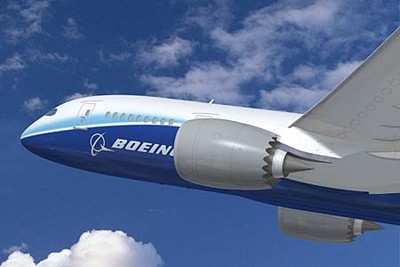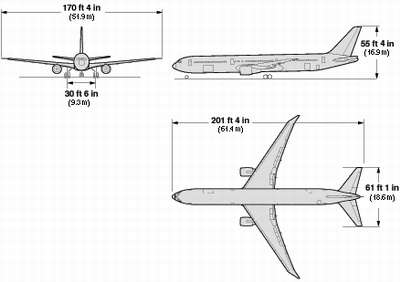Now Offering Customers GREAT Deals On 767-500 'Miserliner'
ANN APRIL 1st 'SPECIAL EDITION': "Enough!" That
was the word from The Boeing Company on Tuesday, as the American
planemaker shocked the aviation community with its decision to
discontinue further development on the delay-plagued,
composite-bodied 787 Dreamliner.

In his speech to Boeing line workers at its widebody production
plant and assembled media, Boeing Commercial Airplanes CEO Scott
Carson said the confluence of a number of difficulties on the 787
-- ranging from fastener shortages, systems integration issues, and
supplier woes -- pushed Boeing in the direction of scrapping the
787 program, but it wasn't the final determining factor.
"With the Air Force's decision to award the KC-X tanker bid to
Northrop Grumman and EADS, we're left with the 767 production line
that, as it stands, would be shut down in just a few years," Carson
said.
 "We love the 767, and
feel the airframe has many, many years left in it... Many
trouble-free years, using parts that suppliers are used to
building, from materials they're used to working with, assembled
with common fasteners, with no need to transport large body
sections onboard expensive converted 747s."
"We love the 767, and
feel the airframe has many, many years left in it... Many
trouble-free years, using parts that suppliers are used to
building, from materials they're used to working with, assembled
with common fasteners, with no need to transport large body
sections onboard expensive converted 747s."
Carson also announced the airliner program Boeing hopes current
787 customers will transfer they're order books to: the upcoming,
ultra-long-range, 767-500 "Miserliner," scheduled to enter service
by 2016.
"That's with a long "i," Carson explained, "not like in
'miserable.'"
Fitted with the high-bypass GEnx turbofans developed for the 787
program and other advanced technologies, Boeing projects the
767-500 Miserliner "will deliver to its customers roughly 85
percent the efficiencies over current models we had predicted for
the 787... which, hey, isn't bad," Carson added.
Despite the positive "spin," Carson's surprise announcement sent
Boeing shares tumbling, and customers for what had been Boeing's
best-selling commercial aircraft scrambling.
"We had no idea it was this bad," said Bubbles Yamagura,
spokesperson for 787 launch customer All Nippon Airways. "[Boeing]
kept us apprised on the delays... but we thought those issues had
been addressed. In fact, we expected an announcement of first
power-up today, not the total abandonment of the program."
"Our airline prides itself on being at the cutting edge of
technology and innovation," Yamagura added. "It is unlikely
we'll chose to transfer our orders to an airframe that's been
behind the times for the past 10 years, even if it does have fancy
new engines."
Steven Udvar-Hazy -- the outspoken and influential chief of
International Lease Finance Corp., the single largest customer for
the 787 -- was even more verbose in his criticism of Boeing's
about-face.

"Today, April 1, 2008, is the date Boeing officially conceded
the commercial airliner market to Airbus and other rivals," Hazy
slammed. "I've certainly had my doubts with the timeframes Boeing
had given to date regarding the Dreamliner, but never did I imagine
Boeing would stoop to cancelling the project. They're going to lose
billions in orders, and trillions in reputation in the
marketplace!"
Boeing's Carson downplayed such fears, noting the planemaker's
737 narrowbody and 777 twinjet widebody airliners continue to be
fast-sellers... which should help Boeing recoup, over time, the
$347 billion loss the planemaker is expected to incur in FY 2008
due to the cancellation of the 787 program.
In the end, Carson said, the decision to stick with proven
technologies will prove to be the best choice for Boeing, and its
customers.
 "It seldom pays to be
the innovator," Carson said, waxing philosophical. "Often, the guy
who is second to the finish line actually wins the race, when you
speak of profitability. We've no doubt composite technologies will
be seen in commercial airliners in the near future... but not as
soon as we had hoped, and not carrying a Boeing logo.
"It seldom pays to be
the innovator," Carson said, waxing philosophical. "Often, the guy
who is second to the finish line actually wins the race, when you
speak of profitability. We've no doubt composite technologies will
be seen in commercial airliners in the near future... but not as
soon as we had hoped, and not carrying a Boeing logo.
"And good grief to all that fancy-pants carbon fiber
construction, high-humidity cabin air systems, and integrated
cockpit and cabin electronics nonsense that allows any 14-year-old
with an iPod to reroute the plane inflight to Hannah, MT, where
ever that is," Carson added.
"Let Airbus try to do it with its A350 XWB. Heck, they probably
had the right idea from the start, with that re-winged A330
concept, before they decided to follow us down the primrose path of
composite fuselages."
 Aero-News: Quote of the Day (04.28.25)
Aero-News: Quote of the Day (04.28.25) ANN's Daily Aero-Term (04.28.25): Decision Altitude (DA)
ANN's Daily Aero-Term (04.28.25): Decision Altitude (DA) ANN's Daily Aero-Linx (04.28.25)
ANN's Daily Aero-Linx (04.28.25) Airborne-Flight Training 04.24.25: GA Refocused, Seminole/Epic, WestJet v TFWP
Airborne-Flight Training 04.24.25: GA Refocused, Seminole/Epic, WestJet v TFWP Aero-News: Quote of the Day (04.29.25)
Aero-News: Quote of the Day (04.29.25)





